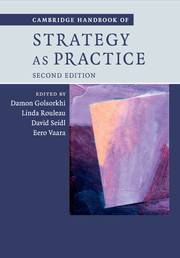Book contents
- Frontmatter
- Contents
- List of figures
- List of tables
- List of boxes
- List of contributors
- Preface to the Second Edition
- Introduction: what is strategy as practice?
- Part I Ontological and Epistemological Questions
- Part II Theoretical Resources: Social Theory
- Part III Theoretical Resources: Organization and Management Theories
- 16 An institutional perspective on strategy as practice
- 17 Relating strategy as practice to the resource-based view, capabilities perspectives and the micro-foundations approach
- 18 Theory of routine dynamics and connections to strategy as practice
- 19 Identity work as a strategic practice
- 20 Sensemaking in strategy as practice: a phenomenon or a perspective?
- 21 The communicative constitution of strategy-making: exploring fleeting moments of strategy
- 22 Analytical frames for studying power in strategy as practice and beyond
- 23 A critical perspective on strategy as practice
- Part IV Methodological Resources
- Part V Substantive Topic Areas
- Index
- References
23 - A critical perspective on strategy as practice
from Part III - Theoretical Resources: Organization and Management Theories
Published online by Cambridge University Press: 05 October 2015
- Frontmatter
- Contents
- List of figures
- List of tables
- List of boxes
- List of contributors
- Preface to the Second Edition
- Introduction: what is strategy as practice?
- Part I Ontological and Epistemological Questions
- Part II Theoretical Resources: Social Theory
- Part III Theoretical Resources: Organization and Management Theories
- 16 An institutional perspective on strategy as practice
- 17 Relating strategy as practice to the resource-based view, capabilities perspectives and the micro-foundations approach
- 18 Theory of routine dynamics and connections to strategy as practice
- 19 Identity work as a strategic practice
- 20 Sensemaking in strategy as practice: a phenomenon or a perspective?
- 21 The communicative constitution of strategy-making: exploring fleeting moments of strategy
- 22 Analytical frames for studying power in strategy as practice and beyond
- 23 A critical perspective on strategy as practice
- Part IV Methodological Resources
- Part V Substantive Topic Areas
- Index
- References
Summary
Introduction
During the last two decades the strategy-as-practice perspective has emerged, from what is often claimed to be a growing discontent with much of current, mainstream strategy research. In particular, the fact that human actors and their actions in strategy research have been lost to sight has been acknowledged (Jarzabkowski, Balogun and Seidl 2007; Jarzabkowski and Spee 2009). Sometimes the perspective is said to contribute with a ‘sociological eye’ (Whittington 2007) on strategy and strategists, as opposed (or, at least, as a complement) to mainstream, mainly North-American-inspired strategic management research, with its reductionist, economics-based assumptions about firms and industries. The ambition is to move away from the abstract statistical analysis of performance effects and instead, in the tradition of process-oriented strategy scholars such as Mintzberg (1973) and Pettigrew (1973), open up the ‘black box’ of strategy work (Golsorkhi et al. 2010). Foundational works, such as those by Balogun and Johnson (2004), Hendry (2000), Jarzabkowski (2003; 2004; 2005), Johnson, Melin and Whittington (2003) and Whittington (1996; 2004), have ignited (but also framed) an impressive research activity during the last ten years. Strong research groups focusing on strategy as practice have emerged during this period, especially in the United Kingdom, Canada and Finland; an SAP online community (the Strategy as Practice International Network) has been established; and numerous papers have been presented at major conferences (many of which have been published later in prestigious journals). In other words, much has been achieved; as always, though, it is important to be (self-)critical and reflect upon a growing, popular and seemingly successful body of knowledge (Alvesson and Deetz 2000) such as strategy as practice.
The purpose of this chapter is twofold: (1) to review and comment on strategy as practice from a critical perspective; and (2) to suggest how a critical perspective – and, in particular, critical management studies (CMS) – can be leveraged in a future research agenda. The structure of the chapter will follow this logic. After this short introduction, we continue by illuminating what we (and others) see as problems, shortcomings or pitfalls with current SAP research. This is partly done from a CMS perspective. We then continue with a section that briefly outlines critical management studies, and in particular how it can be further incorporated in SAP research. A summary section concludes the chapter.
A critical perspective on strategy as practice
- Type
- Chapter
- Information
- Cambridge Handbook of Strategy as Practice , pp. 405 - 428Publisher: Cambridge University PressPrint publication year: 2015
References
- 5
- Cited by



